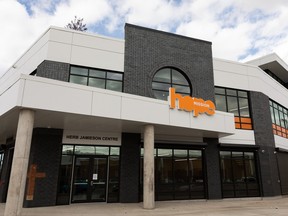
Article content
Assault numbers at Edmonton’s two largest shelters have been on the rise, but one researcher says the numbers are lower than he would have expected.
According to documents obtained by the Coalition for Justice and Human Rights via a freedom of information request, there was a total of 550 reported occurrences, of which 443 were categorized as assaults, since 2021 between both the Herb Jamieson and Hope Mission. The remaining occurrences include sudden deaths, or cases involving domestic abuse or sexual offences.
Advertisement 2
Article content
Damian Collins, a professor of human geography at the University of Alberta who specializes in housing and homelessness issues, said he is surprised by how low the number of reported assaults were given the increase in the number of people going to shelters.
“It was really interesting to see this data because we know that one of the reasons that some homeless people give for not going to shelters or preferring not to is because of the risk of assault and violence within the shelters or immediately outside,” Collins said. “That’s an issue reported not just in Edmonton, but across Canada and North America.”
Overall, annual assaults at the two shelters totalled 103 in 2021; 142 in 2022; and 143 in 2023; with 55 reported so far this year (from Jan. 1 to March 31).
Of the total 443 assaults recorded, 156 of them were categorized as assault with a weapon or cause bodily harm — which have also been trending upwards with 31 reported in 2021; 44 in 2022; and 59 in 2023; and 22 reported so far this year.
The number of sudden deaths in the two shelters reached 18 in both 2021 and 2022, respectively, before sharply rising to 44 in 2023. So far, seven sudden deaths have been reported this year.
Article content
Advertisement 3
Article content
Collins said solutions could be taken to lower the number of assaults happening in shelters, including increased staff training around de-escalating tense situations that could result in an assault and working to address overcrowding levels.
Keith Johnson, the acting deputy chief of the Edmonton Police Service community safety and well-being bureau, said their role is to provide community safety. While he could not comment on the types of assaults happening in shelters he said their teams are utilizing data to be in the necessary areas to help prevent altercations and crimes in the shelter districts.
“We’re doing our best to address the crime and disorder in all areas of the city. But in the Healthy Streets Operation Centre zone itself, there’s immense challenges in there. It’s difficult for a lot of the businesses in the area. We want to be more visible and that’s the biggest thing,” Johnson said.
Bacteria and viral outbreaks a symptom of overcrowding
Between 2023 and 2024, Alberta Health Services health inspection teams responded to a number of incidents regarding cleanliness complaints, including surprise visits. From the reports, management at both the Hope Mission and Herb Jamieson were quick to comply with concerns, but issues of overcrowding were noted multiple times.
Advertisement 4
Article content
“The staff and the management at the two shelters are working pretty diligently. Having said that, obviously there are problems on other visits and in particular what we see is issues with bacterial infections with parasites like lice and bedbugs,” Collins said.
Shigella outbreaks were noted throughout the reports where staff were instructed to be diligent and be sure to isolate those who were sick. In closing comments in an AHS report from Jan. 19 regarding the Herb Jamieson Centre, AHS said staff struggled to maintain cleanliness in the colder months with a “very high volume of clients using services and mats extremely close together.”
“Staff conduct deep cleaning of shelters twice weekly and conduct cleaning on daily basis. The team observed staff cleaning mats in the intox shelter, as well as custodial staff cleaning other shelter areas. AHS requested staff remove several damaged mats from the floor, which was complied with immediately,” the report said.
Collins said reports of bacterial and parasite outbreaks is largely due to overcrowding.
“The closer that those sleeping mats or the closer those bunks are together, the more opportunity there is for parasites or bacteria to spread and there’s only so much shelters can do about that, especially when there’s cold weather and they have hundreds of people who need to come inside,” Collins said.
Advertisement 5
Article content
In a statement to Postmedia, the Hope Mission said it works closely with AHS inspectors and take any issues of non-compliance seriously.
“Hope Mission works hard to address any deficiencies noted and rectify those as quickly as possible,” the statement said. “We have a robust system of assessment and updating in place to improve upon the care offered in shelters.
“People who access services at Hope Mission often have complex needs and our teams do their best to support every individual while also supporting the health and safety needs of staff and clients.”
Recommended from Editorial
X: @kccindytran
Bookmark our website and support our journalism: Don’t miss the news you need to know — add EdmontonJournal.com and EdmontonSun.com to your bookmarks and sign up for our newsletters here.
You can also support our journalism by becoming a digital subscriber. Subscribers gain unlimited access to The Edmonton Journal, Edmonton Sun, National Post and 13 other Canadian news sites. Support us by subscribing today: The Edmonton Journal | The Edmonton Sun.
Article content





